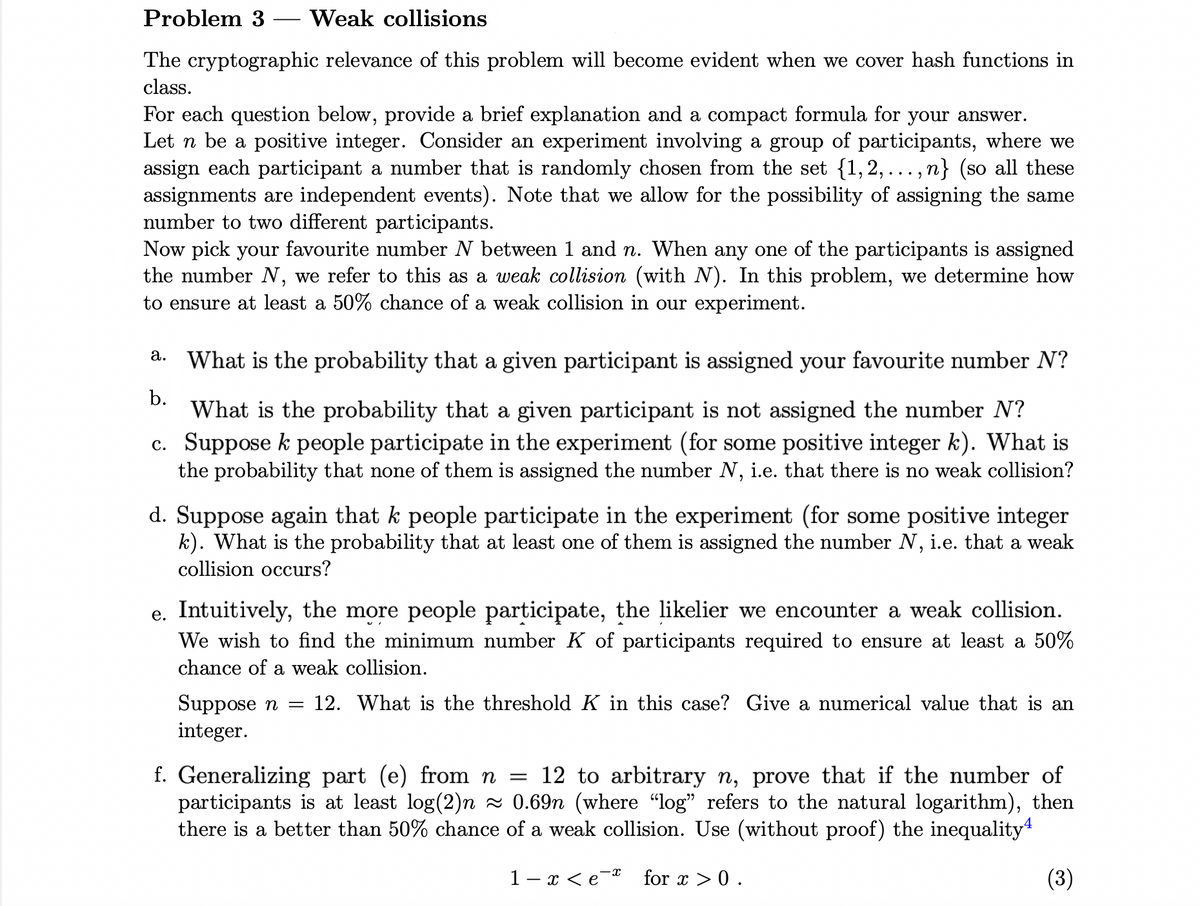The cryptographic relevance of this problem will become evident when we cover hash functions in class. For each question below, provide a brief explanation and a compact formula for your answer. Let n be a positive integer. Consider an experiment involving a group of participants, where we assign each participant a number that is randomly chosen from the set {1,2,...,n} (so all these assignments are independent events). Note that we allow for the possibility of assigning the same number to two different participants. Now pick your favourite number N between 1 and n. When any one of the participants is assigned the number N, we refer to this as a weak collision (with N). In this problem, we determine how to ensure at least a 50% chance of a weak collision in our experiment. a. What is the probability that a given participant is assigned your favourite number N? b. What is the probability that a given participant is not assigned the number N? c. Suppose k people participate in the experiment (for some positive integer k). What is the probability that none of them is assigned the number N, i.e. that there is no weak collision?
The cryptographic relevance of this problem will become evident when we cover hash functions in class. For each question below, provide a brief explanation and a compact formula for your answer. Let n be a positive integer. Consider an experiment involving a group of participants, where we assign each participant a number that is randomly chosen from the set {1,2,...,n} (so all these assignments are independent events). Note that we allow for the possibility of assigning the same number to two different participants. Now pick your favourite number N between 1 and n. When any one of the participants is assigned the number N, we refer to this as a weak collision (with N). In this problem, we determine how to ensure at least a 50% chance of a weak collision in our experiment. a. What is the probability that a given participant is assigned your favourite number N? b. What is the probability that a given participant is not assigned the number N? c. Suppose k people participate in the experiment (for some positive integer k). What is the probability that none of them is assigned the number N, i.e. that there is no weak collision?
Elements Of Modern Algebra
8th Edition
ISBN:9781285463230
Author:Gilbert, Linda, Jimmie
Publisher:Gilbert, Linda, Jimmie
Chapter2: The Integers
Section2.7: Introduction To Coding Theory (optional)
Problem 12E: Suppose that the check digit is computed as described in Example . Prove that transposition errors...
Related questions
Question

Transcribed Image Text:Problem 3 Weak collisions
The cryptographic relevance of this problem will become evident when we cover hash functions in
class.
For each question below, provide a brief explanation and a compact formula for your answer.
Let n be a positive integer. Consider an experiment involving a group of participants, where we
assign each participant a number that is randomly chosen from the set {1,2,...,n} (so all these
assignments are independent events). Note that we allow for the possibility of assigning the same
number to two different participants.
Now pick your favourite number N between 1 and n. When any one of the participants is assigned
the number N, we refer to this as a weak collision (with N). In this problem, we determine how
to ensure at least a 50% chance of a weak collision in our experiment.
b.
a. What is the probability that a given participant is assigned your favourite number N?
What is the probability that a given participant is not assigned the number N?
c. Suppose k people participate in the experiment (for some positive integer k). What is
the probability that none of them is assigned the number N, i.e. that there is no weak collision?
d. Suppose again that k people participate in the experiment (for some positive integer
k). What is the probability that at least one of them is assigned the number N, i.e. that a weak
collision occurs?
e. Intuitively, the more people participate, the likelier we encounter a weak collision.
We wish to find the minimum number K of participants required to ensure at least a 50%
chance of a weak collision.
Suppose n = 12. What is the threshold K in this case? Give a numerical value that is an
integer.
f. Generalizing part (e) from n = 12 to arbitrary n, prove that if the number of
participants is at least log(2)n≈ 0.69n (where "log" refers to the natural logarithm), then
there is a better than 50% chance of a weak collision. Use (without proof) the inequality
1-x<e¯¤ for x > 0.
(3)
Expert Solution
This question has been solved!
Explore an expertly crafted, step-by-step solution for a thorough understanding of key concepts.
Step by step
Solved in 2 steps

Recommended textbooks for you

Elements Of Modern Algebra
Algebra
ISBN:
9781285463230
Author:
Gilbert, Linda, Jimmie
Publisher:
Cengage Learning,

Linear Algebra: A Modern Introduction
Algebra
ISBN:
9781285463247
Author:
David Poole
Publisher:
Cengage Learning

Algebra for College Students
Algebra
ISBN:
9781285195780
Author:
Jerome E. Kaufmann, Karen L. Schwitters
Publisher:
Cengage Learning

Elements Of Modern Algebra
Algebra
ISBN:
9781285463230
Author:
Gilbert, Linda, Jimmie
Publisher:
Cengage Learning,

Linear Algebra: A Modern Introduction
Algebra
ISBN:
9781285463247
Author:
David Poole
Publisher:
Cengage Learning

Algebra for College Students
Algebra
ISBN:
9781285195780
Author:
Jerome E. Kaufmann, Karen L. Schwitters
Publisher:
Cengage Learning